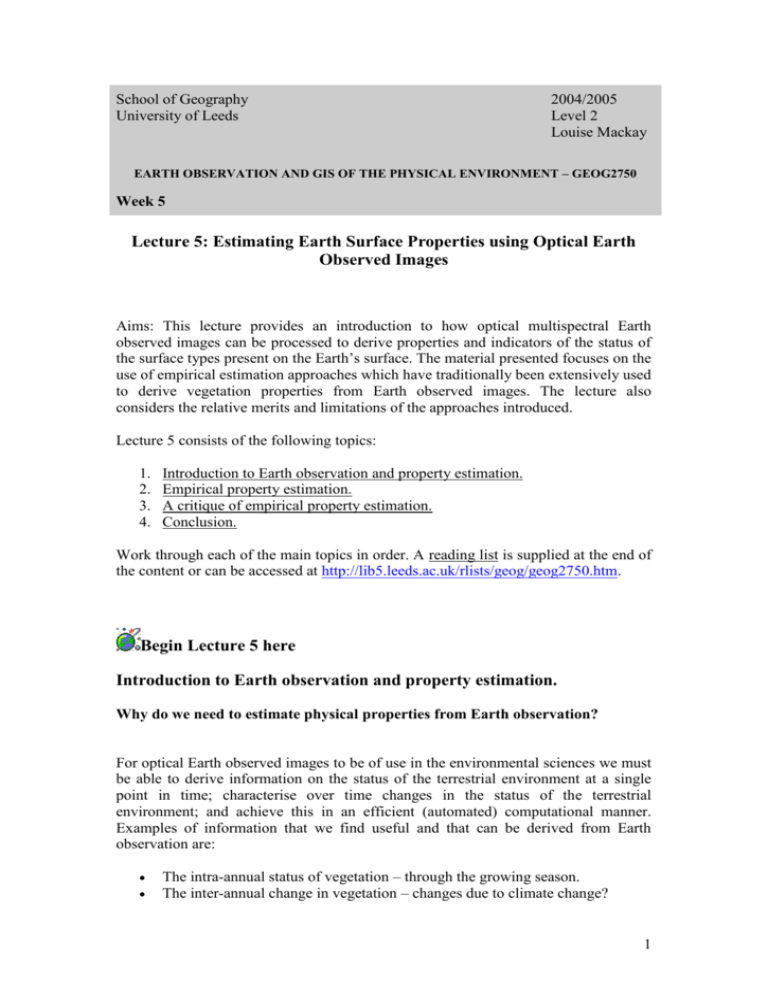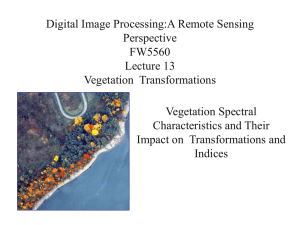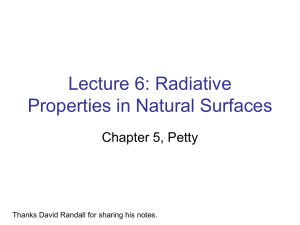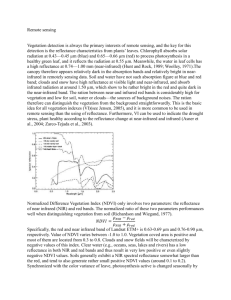Lecture 5: Estimating Earth Surface Properties using Optical Earth
advertisement

School of Geography University of Leeds 2004/2005 Level 2 Louise Mackay EARTH OBSERVATION AND GIS OF THE PHYSICAL ENVIRONMENT – GEOG2750 Week 5 Lecture 5: Estimating Earth Surface Properties using Optical Earth Observed Images Aims: This lecture provides an introduction to how optical multispectral Earth observed images can be processed to derive properties and indicators of the status of the surface types present on the Earth’s surface. The material presented focuses on the use of empirical estimation approaches which have traditionally been extensively used to derive vegetation properties from Earth observed images. The lecture also considers the relative merits and limitations of the approaches introduced. Lecture 5 consists of the following topics: 1. 2. 3. 4. Introduction to Earth observation and property estimation. Empirical property estimation. A critique of empirical property estimation. Conclusion. Work through each of the main topics in order. A reading list is supplied at the end of the content or can be accessed at http://lib5.leeds.ac.uk/rlists/geog/geog2750.htm. Begin Lecture 5 here Introduction to Earth observation and property estimation. Why do we need to estimate physical properties from Earth observation? For optical Earth observed images to be of use in the environmental sciences we must be able to derive information on the status of the terrestrial environment at a single point in time; characterise over time changes in the status of the terrestrial environment; and achieve this in an efficient (automated) computational manner. Examples of information that we find useful and that can be derived from Earth observation are: The intra-annual status of vegetation – through the growing season. The inter-annual change in vegetation – changes due to climate change? 1 The inter-annual change in glacier surface conditions – again due to climate change? REMEMBER: images are data; they need to be processed to derive properties that are relevant to address and quantify the above. The estimation of surface properties involves moving from images of recorded atsensor radiance to estimation of physical properties of the Earth’s surface. Examples of which are the determinations of vegetation health, glacier surface condition, soil surface moisture, organic matter etc. Some property estimation approaches require atmospherically corrected multispectral data and sometimes hyperspectral data in order to estimate at-surface reflectance and/or high temporal repeat to provide monthly intra-annual changes. Property estimation approaches can involve: (i) Simple empirical approaches which are relatively easy to apply and/or, (ii) Complex approaches that attempt to derive surface properties using numerical approaches to invert physically-based reflectance models. The use of empirical approaches will be addressed in this lecture. Empirical property estimation. Empirical approaches attempt to use a broad knowledge of the reflectance characteristics of surface features in order to derive an indication of surface state. They are data driven in that they only employ the image data to derive an indication of surface state. They do not attempt to include any formal (mathematical) expression of how reflectance is influenced by different surface states. Empirical approaches are used in a number of different terrestrial environments as they are simple to employ and easy to understand. A simple to use empirical approach is that of Image Ratio’s. Image ratio's use the expected reflectance characteristics of certain multispectral image spectral bands to derive a ratio. The underlying rationale is that the resulting ratio values indicate different states or properties of surface features. In order to be applied they require knowledge of how the spectral reflectance of surface features varies due to a change in their status. For example: (i) How the multispectral reflectance of vegetation changes as a function of health, biomass etc., or (ii) How the multispectral reflectance of glacier surface changes as a function of different snow/ice properties/type. 2 Question From your knowledge of the reflectance of vegetation which spectral wavelengths would you ratio to get an index that possibly indicates vegetation health/biomass? Hint - look at the spectral reflectance of the woodland example in Figure 1 to the right. Figure1 from: Lillesand, T.M., and Kiefer, R.W., 2000. Remote sensing and image interpretation. Wiley (Chichester). p17. You may have noticed the high reflectance of the woodland example in the Red and NIR spectral regions. A ratio of the reflectance in these two regions would in fact produce a well known image ratio - the Vegetation Index. The simple vegetation index would be: However, normally the Normalised Difference Vegetation Index (NDVI) is used (note the NDVI ranges): 3 The advantage of the NDVI above that of the VI is that is does not depend on absolute RED and NIR values and has fixed easy to understand bounds, i.e. -1.0 indicates very low NDVI and hence low vegetation greenness and 1.0 indicates very high NDVI and hence high vegetation greenness. The NDVI is routinely used to derive continental and global estimates of vegetation vigour (health) using time-series averaged AVHRR images, see Figure 2 below. Vigorous vegetation tends to have a NDVI of 0.65-0.80. Senescent or stressed vegetation tends to have a NDVI of 0.0-0.3. Figure 2: A global NDVI data set produced from time-series AVHRR images. Yellow tones have a higher NDVI than blue/purple tones. 4 A number of derivatives of the NDVI have also been developed: 1. The (Optimised) Soil-Adjusted Vegetation Index (OSAVI): 2. The Enhanced Vegetation Index (EVI): Look at Figure 3 below and compare the usefulness of the EVI (far right) to the NDVI? Figure 3images courtesy of University of Arizona Terrestrial Biophysics and Remote Sensing Lab see: http://tbrs.arizona.edu/project or see: http://tbrs.arizona.edu/project/MODIS/evi.php. 5 We can see in Figure 3 above that in this instance the NDVI clearly shows the impact of the forest fire on the vegetation (the black scarring is clearly apparent in the middle NDVI image). However, in Figure 4 below we can see the EVI is more useful in this instance as atmospheric haze (bright white tones) is occurring over the imaged area, (remember the EVI applies an atmospheric correction). Therefore not all ratio indices are appropriate for the same image or environment. Figure 4: NDVI and EVI map of South America. Other Environmental Ratio’s/Indices Ratio’s can be used in a variety of environmental applications. However, their successful use requires a good knowledge of the environment and a good knowledge of its reflectance characteristics and sensor bands. For example, ratios have been used in an attempt to map different glacier surface facies (Figure 5 below) by highlighting the changes down glacier: from snow to firn to glacier-ice to dirty-ice. Action point: quickly look up the glaciological terms I have used here if you are not familiar with them in order to understand their different physical properties. 6 Figure 5: Landsat TM ratio images for recognition of glacial facies. Note: Choosing the correct spectral-bands for the reflectance characteristics of the environment is critical. For glaciers the use of visible and near infrared wavelengths (spectral-bands) is very problematic, as you can see in Figure 6 below. Figure 6: Reflectance of glacial features with a summary example of the problems encountered when using band ratios for specific features. Note: by looking at the problematic example on the right (Figure 6) we can see that our knowledge of glacier surface reflectance (Figure 6 left hand image) suggests that a better combination would be the near infrared and middle infrared for the following reasons: – Reflectance of Snow in the near-infrared is high (0.90). – Reflectance of Ice in the near-infrared is low (0.30). – Reflectance of both Snow and Ice is very low (0.1). Therefore a ratio of TM band 4/TM band 5 would be useful to distinguish transition zones (facies). For example, if we apply this ratio to some theoretical examples, snow 0.9/0.1 = 9, ice 0.3/0.1 = 3, we can see that using the TM4/TM5 ratio would more clearly distinguish these glacier facies unlike the summary example for the snow and firn in Figure 6 above. 7 A critique of empirical property estimation Historically, ratio indices have found huge popularity for the derivation of properties about the surface conditions of scenes acquired by Earth observation. For example, the NDVI is the primary means of assessing vegetation at global scales. Near and middle infrared indices are used for tropical forest vegetation biomass estimation and one-off ratios are used for glacier surface facies as discussed in the above example. Although ratio indices are simple-to-use empirical approaches, their use is being increasingly questioned, for the following reasons: (i) They often seem to be devised in an ad-hoc manner. (ii) They are nearly always a surrogate variable of the physical property that is actually required by the application scientist. Therefore, they may have little meaning in terms of the bio-physical properties of the acquired scene. (iii) They are often applied without consideration of the actual image acquisition process. Note: if ratio indices are a "surrogate variable", what exactly do we mean by that? As an example the NDVI, which is easy to calculate, is often used to approximate the physical property Fraction of Absorbed Photosynethetically Active Radiation (FAPAR). In practice scientists often require the physical property (FAPAR) and not the surrogate variable (NDVI). Therefore, this requires that the relationship between the ratio (NDVI) and the variable of interest is established (FAPAR). Often this can only be established by the use of statistical estimation (regression), see Figure 8 below which attempts to correlate measured NDVI with a series of modelled FAPAR estimates. 8 Figure 8: Estimates of FAPAR from NDVI for a series of experimental simulations. Note: Fraction of Absorbed Photosynthetically Active Radiation (FAPAR) is the proportion of available radiation at photosynthetically active wavelengths (0.3-0.7 micrometers) absorbed by canopy. In vegetation studies information on total biomass and chlorophyll are two example properties often required for environmental modelling. However, as we can see by Figure 8 above, the NDVI may or may not be a linear surrogate variable for FAPAR and in many cases the relationship is more complex. Similarly the relationship between the NDVI or MSAVI and Leaf Area Index (LAI) as shown in Figures 9 and 10 below is also complex. Therefore the use of simple empirical approaches to explain multiple biophysical properties is questionable. 9 Figure 9: NDVI/LAI Figure 10: MSAVI/LAI For further reading on this subject see: Baret and Guyot (1991); Defries and Townshend (1994); Leprieur et al. (1996). Points to consider for image acquisition when estimating empirical properties Image acquisition considerations: Ratio’s are often derived for images representing digital numbers (DN) and tend not to be properly pre-processed at-ground reflectance, i.e., ratios are often derived without accounting for path-radiance and atmospheric scattering. If interest is seasonal time-series analysis then no account of changes in irradiance and sun zenith is accounted for - this makes objective comparison virtually impossible. If interest is multi-year time-series then beware of drift in a sensors pre-flight gain and offset calibration - as occurs with the AVHRR sensor. If interest is multi-year time series then beware of using a new launch in a series of the same satellite/sensor - e.g., AVHRR. If interest is time series and using different sensors remember that they will have different at-sensor radiance gain and offset and different spectral band widths for Red and NIR. Action point: Make a list of the main vegetation ratios used in Earth observation, look at the bands used and from your understanding of vegetation reflectance make a considered critique of the advantages of the ratios you research. Begin with the MSAVI! 10 Conclusion Being able to estimate Earth surface properties is a key application of Earth observation. This has historically been achieved by simple empirical means such as ratioing different spectral bands. Recently we have seen improved ratio approaches which attempt to incorporate a deeper understanding of the interactions of electromagnetic radiation at the Earth’s surface. Although these simple approaches are very popular they are quite heavily criticised. However, they are still an important approach for the production of physical properties e.g., MODIS EVI product (as seen previously in Figure 4 above). Why is this lecture important? This lecture demonstrates how many remote sensing studies process multispectral images in order to provide estimates of surface conditions for use in environmental mapping, monitoring and modelling. The approaches discussed have been extensively used to provide estimates of the status of the Earth's terrestrial environment from the global to local scale. The resulting data sets are often incorporated into Geographical Information Systems, and thus form an important source of information available for use in characterising the terrestrial environment using GIS. Reading list: 1. Baret, F., and Guyot, G., 1991. Potential and limitations of vegetation indices for LAI and PAR assessment. Remote Sensing of Environment, 35, 161-173. 2. Boyd, D.S., and Ripple, W.J., 1997. Potential vegetation indices for determining global forest cover. International Journal of Remote Sensing, 18(6), 1395-1401. 3. Defries, R., and Townshend, J. R.G., 1994. NDVI derived land cover classifications on a global scale. International Journal of Remote Sensing, 15(7), 3567-3586. 4. Filella, I., and Penuelas, J., 1994. The red edge position and shape as indicators of plant chlorophyll content, biomass and hydric status. International Journal of Remote Sensing, 15, 1459-1470. 5. Gutman, G., and Ignatov, A, 1995. Global land cover monitoring from AVHRR: potential and limitations. International Journal of Remote Sensing, 16, 2301-2309. 6. Huete, A.R., 1988. A soil-adjusted vegetation index (SAVI), Rem. Sens. Environ. 25:295-309. 7. Kaufman, Y.J. and Tanré, D., 1992, Atmospherically resistant vegetation index (ARVI) for EOS-MODIS, IEEE Trans. Geosci. Remote Sensing, 30:261-270. 8. Leprieur, C., Kerr, Y.H., and Pichon, J.M., 1996. Critical assessment of vegetation indices from AVHRR in a semi-arid environment. International Journal of Remote Sensing, 17, 2549-2563. 11 9. Miura, T., Huete, A.R., Yoshioka, H., and Holben, B.N., 2001, An error and sensitivity analysis of atmospheric resistant vegetation indices derived from dark target-based atmospheric correction, Remote Sens. Environ., 78:284-298. 10. Miura, T., Huete, A.R., van Leeuwen, W.J.D., and Didan, K., 1998, Vegetation detection through smoke-filled AVIRIS images: an assessment using MODIS band passes, J. Geophys. Res. 103:32,001-32,011. 11. Myneni, R.B., Hall, F.G., Sellers, P.J., and Marshak, A.L., 1995. The interpretation of spectral vegetation indicies. IEEE Transactions on Geoscience and Remote Sensing, 33, 481-486. 12. Perry, C.R., and Lautenschlager, L.F., 1984. Functional equivalence of spectral vegetation indices. Remote Sensing of Environment, 14, 169-182. 13. Pinty, B., Leprieur, C., and Verstraete, M.M., 1993. Towards a quantitative interpretation of vegetation indices. Part 1: biophysical canopy properties and classical indices. Remote Sensing Reviews, 7, 127-150. 14. Richardson, A.J. and Wiegand, C.L., 1977, Distinguishing vegetation from soil background information, Photogramm. Eng. And Remote Sens. 43:15411552. 15. Rondeaux, G., Steven, D.M., and Baret, F., 1996. Optimisation of soiladjusted vegetation indices. Remote Sensing of Environment, 55, 95-107. 16. Running, S.W., Justice, C., Salomonson, V., Hall, D., Barker, J., Kaufman, Y.,Strahler, A., Huete, A., Muller, J.P., Vanderbilt, V., Wan, Z.M., Teillet, P., Carneggie,D., 1994. Terrestrial remote sensing science and algorithms planned for EOS/MODIS, Int. J. of Remote Sensing 15:3587-3620. 17. Sellers, P., 1989. Vegetation-canopy reflectance and biophysical properties. In Asrar, G., (ed) Theory and Applications of Optical Remote Sensing. John Wiley, pp 297-335. 18. Todd, S.W, Hoffer, R.M., and Milchunas, D.G, 1998. Biomass estimation on grassed and ungrassed rangelands using spectral indices. International Journal of Remote Sensing, 19, 427-438. 19. Van der Meer, F., van Dijk, P.M., and Weiterhof, A.B., 1995. Digital classification of the contact metamorphic aureole along the Los Pedroches batholith, south central Spain using Landsat Thematic Mapper data. International Journal of Remote Sensing, 16, 1043-1062. 20. Verstraete, M.M. and Pinty, B., 1996, Designing optimal spectral indexes for remote sensing applications, IEEE Trans. Geosci. And Remote Sensing, 34:1254-1265. 21. Williams, R., Hall, D., and Benson, C., 1991. Analysis of glacier facies using satellite techniques. Journal of Glaciology, 37(125), 120-128. NOTE: access the practical session 5 handout at the beginning of Week 6 from the Nathan Bodington Geog2750 practical material room prior to the Week 6 timetabled practical class. You can download the practical handout to your ISS folder, keep your downloaded practical handout document open or print off a copy for the practical session. Content developer: Louise Mackay, School of Geography, University of Leeds. 12








